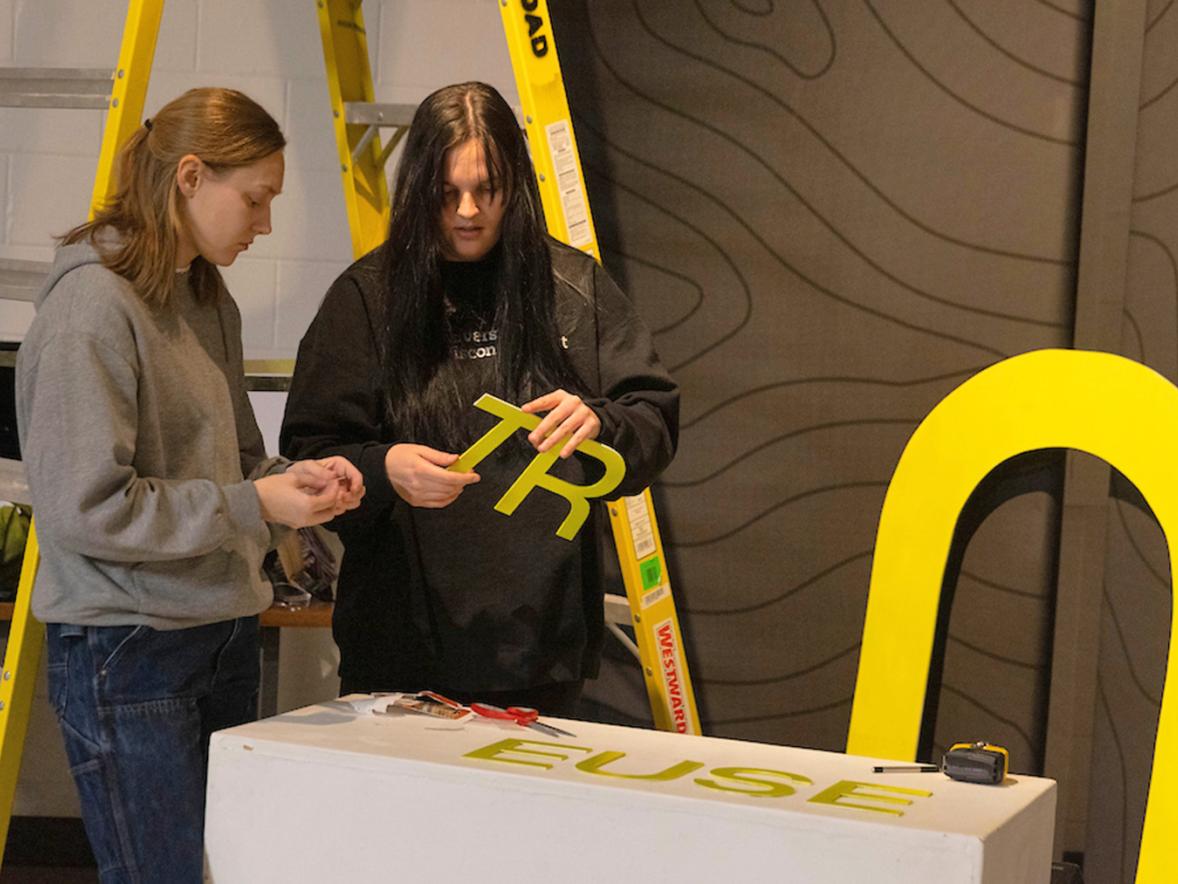With skilled graphic communications and design professionals in high demand across the world, the reputation of UW-Stout’s Bachelor of Science in graphic communications and design programs makes them well-positioned to fill industry demands.
“That demand is especially strong in the Midwest because of strong print centers in the Fox Valley, Chicago and Minneapolis,” said Program Director Andrew Delong of the graphic communications industry. “Because of the strong demand for qualified grads, industry and organizations are offering scholarships to those pursuing a degree in graphic communications, including from the Print and Graphics Scholarship Foundation.”
Given its emphasis on industry partnerships and collaboration, UW-Stout students in these disciplines have access to unique applied learning experiences that strengthen their workforce readiness even before graduation, and it shows.
Graphic communications graduates have a 100% employment rate, as do graduates of M.F.A. in design, according to Career Services’ First Destination Report.
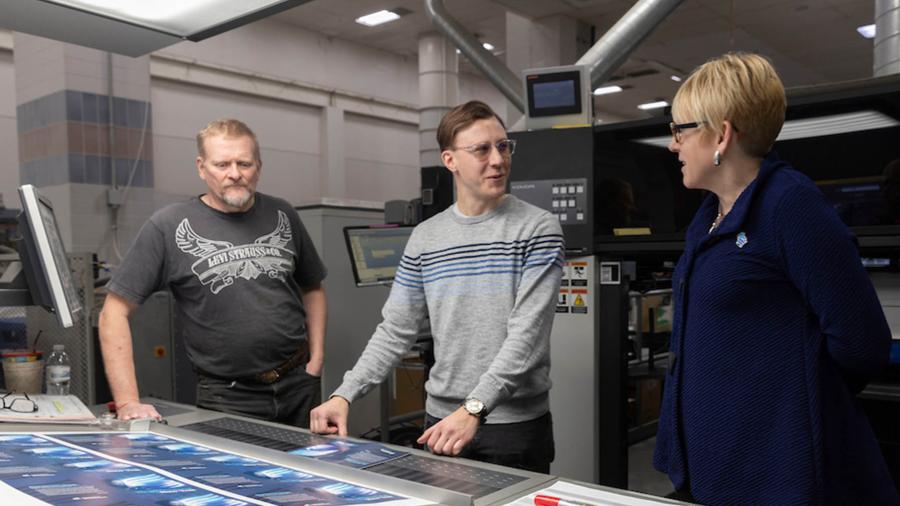
As an undergraduate student at UW-Stout, Jake Cater found that he loved graphic communications. Having been a creator his whole life, he wanted to have a hands-on-part in every step of the creative process, something which he knew UW-Stout offered through its polytechnic model.
Cater turned his interests into a degree and graduated from UW-Stout in 2021 with a bachelor’s in technology education and a minor in graphic media and print management, which helped him stay current with the industry.
He’s now a graphic communications instructor, teaching graphic design and photography at Sheboygan North High School and is continuing his creative passions as an online M.F.A. design student, with an emphasis in graphic and product design.
So, when UW-Stout’s Marketing Communications department announced a competition for students to design a seasonal greeting card for Chancellor Katherine Frank, Cater jumped at the opportunity to showcase his graphic and design talents.
“I love the polytechnic educational model and UW-Stout's branding, so a chance to design something for them was a huge opportunity,” Cater said. “UW-Stout grows more esteemed in my mind as time goes by. It is an institution of higher education of interdisciplinary and hands-on learning at an affordable cost. It is ahead of its time.”
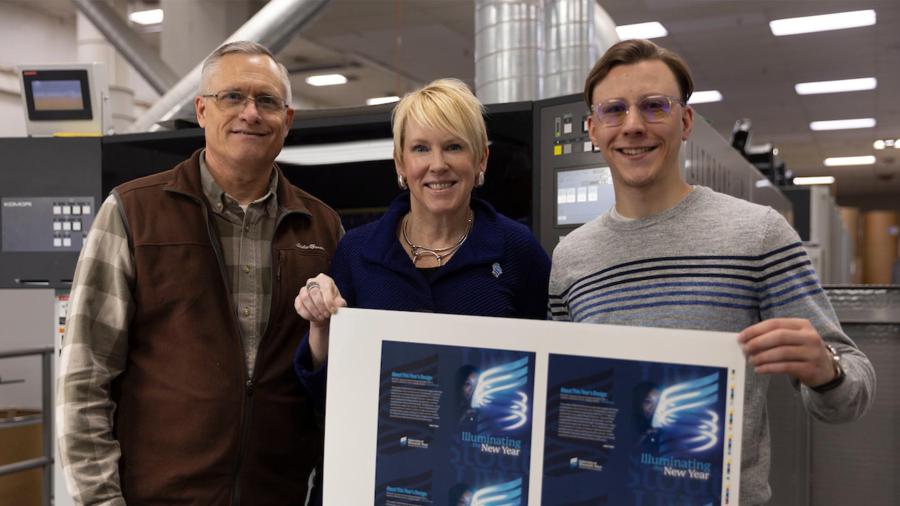
“With the largest public School of Art and Design in the Upper Midwest, UW-Stout offers a huge student talent pool of more than 1,300 students. Add the talent of students in graphic communications, digital marketing and other degrees, and a student competition was the natural option to showcase their talent,” Frank said.
Cater, who was awarded $250 for his design, wanted his design to involve an individual interacting with something unique, “as if a project was just completed,” he said. “I wanted to show what a student is capable of bringing to the table.”
His artist's statement captures his sentiment and visual design:
“As an artist, I’m fascinated by how we physically engage with design, so hands play a role in a lot of my work. For this project, I wanted to explore how an individual might interact with Stout’s “S” logo as a manifestation of innovation through education. I started thinking about traditional technology symbols, like light bulbs, and that transformed into ideas around neon light – something more unique, something the subject had ‘turned on.’ Stout’s polytechnic model is a purposeful one. It trains us to take our ingenuity, fascination and talent and to create something innovative and real. I wanted the individual’s interaction with the logo to recognize both the path toward that end while illuminating the future yet to come.”
Designs were submitted by graphic designers, photographers and illustrators.
“What really stood out about Jake's design was his ability to visually articulate Stout's spirit of applied learning, innovation and discovery, and when we read his accompanying statement, it was clear his submission reflected his relationship with Stout,” Frank said.
Hands-on from start to finish
The design of the chancellor’s seasonal card was only one piece of the puzzle. The next step was to print, cut, fold and mail the card. Cater’s final design was sent to the graphic communications experts at Spectra Print in Stevens Point, a one-stop print shop, offering a full range of services.
Cater and Frank were invited by Spectra owners, siblings Eric and Hans Hofmeister and Heidi Okray, to see the print production process in action.
They were joined by university staff and alumni Production Manager Cheryl Keyes, 1992 industrial technology, graphic arts management; and Printing Manager and graphic communications Lecturer Ryan Dolan, 2016 graphic communications management; as well as members of the Marketing Communications team.
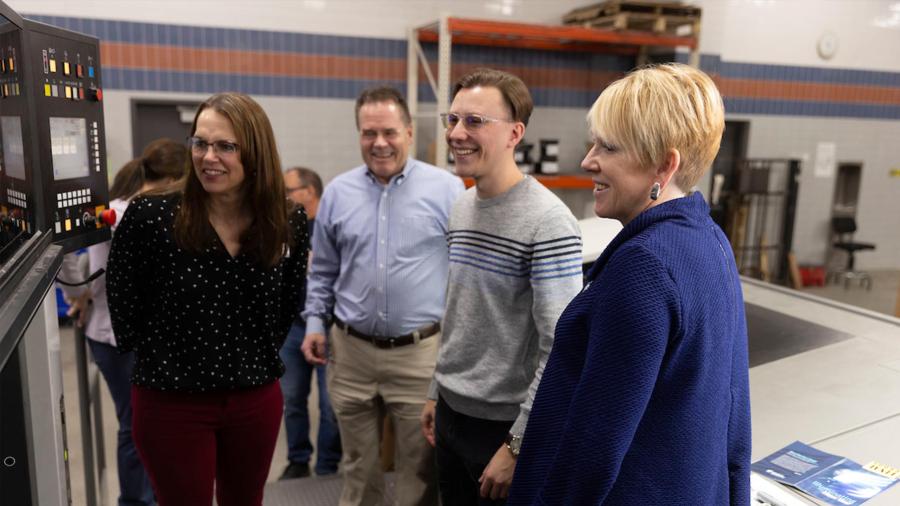
“Part of what made this project unique was our ability to join Jake at Spectra Print as his design came off the press. You will find Stout alumni working in design and print production throughout the country, and you will find both at Spectra. It was wonderful to join Jake and see that working relationship in action,” Frank said.
Among Spectra’s employees are five UW-Stout alumni:
- Kristy Boutain, 1999 graphic communications. She works in customer service and has been at Spectra for eight years.
- Jayne Fuehrer, 1990 graphic design. She is a designer with more than 31 years at the company.
- Scott Hoffmann, 1989 industrial technology, graphic arts. He is a sales representative with more than 33 years in the print industry.
- Kay Rasmussen, 2003 graphic design. She has been a designer with Spectra for 16 years.
- Michael Wendt, 1983 graphic communications management. He is a sales representative with nearly 40 years in the print industry.
Eric, Hans, Heidi and Hoffmann gave Cater and UW-Stout staff a full tour of their facilities during their visit.
“This was an exciting project for us,” Eric said. “We were glad to be a part of it.”

The cards were printed on a Komori Lithrone eight-color perfector printing press, capable of printing 15,000 sheets of paper per hour. The sheets are 25 inches by 38 inches, and 10 cards were printed per sheet, totaling 40 sheets. The job was printed in less than one minute.
During that minute, standing on the press platform and watching the cards turn from a digital to a physical reality, Cater’s and Frank’s excitement matched the industrial roar of the near-semi-trailer-long printer.
The Komori eight-color press uses UV ink. A chemical reaction caused by a strikethrough spot varnish over the UV coating allowed for a shine to make the “S” logo pop on the card.
“It makes the lighting effect on the card pop even more,” Cater said. “When talking about the possibility of the embellishment with the MarCom designers, I could see it in my mind. Seeing it on the actual printed cards, it elevates the design 100%.”
Although Cater has experience in the printing process, including working with UW-Stout’s two-plate lithography press, the visit to Spectra was his first time seeing the process on such a large scale.
“You don’t understand what it means to have this opportunity. It’s very cool,” Cater said.
Cater wants his students to have hands-on experiences in the printing process, as well, and is building connections with print companies in the Sheboygan area in hopes of enhancing their learning experiences.
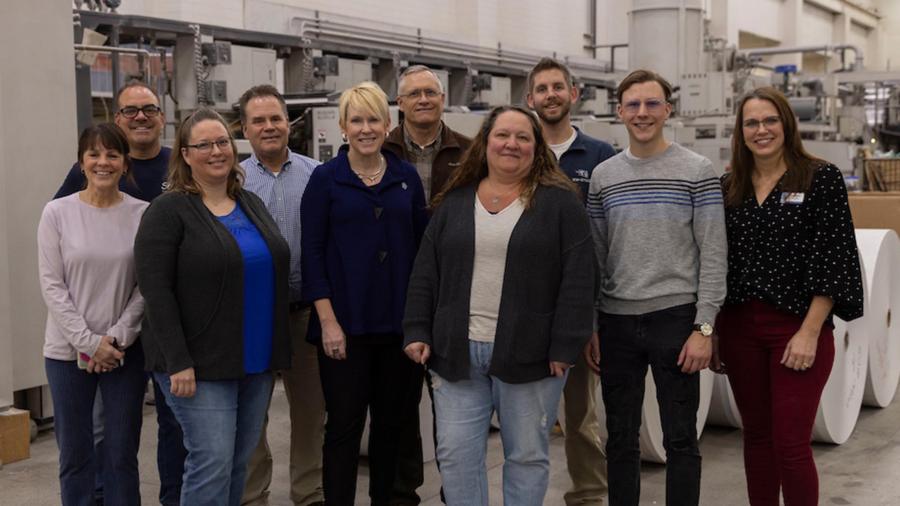
An ambitious maker, involved in every step of the process
Cater’s first printing experiences were in 2014 in his high school technology education classes at Sevastopol High School, in Door County. He ran offset lithography printers and produced two-color business cards and athletics programs.
“I would apply the ink, prep the machine, check color and quality as it ran, and clean the machine once the run was over,” he said.
He also learned different software and designed woodworking projects. He loved the versatility of the work, being a part of every step of the process and that it offered a continuation of learning.
“I also knew of the demand for the position in the workforce,” he said. “UW-Stout was one of the only schools offering a technology education program, and I heard it was the best. Both my high school principal and one of my technology education teachers had attended UW-Stout for tech ed. My grandfather even went for the same degree in the early 1970s. He even stayed in the same dorm as me. It felt right.”
When he began teaching at Sheboygan North, he gained confidence in his craft.
“I needed more though,” he said. “I wanted to learn more about design, and being a top designer and professor is my ultimate goal. I knew UW-Stout’s arts programs were fantastic, as were the companies that I saw classmates getting jobs at, such as MasterCraft and Milwaukee Tool. I later found out that graduates have gone onto top global companies, such as Apple and DreamWorks.”

After talking with M.F.A. design program director and Professor Erik Evensen to learn more about the degree and opportunities it offered, Cater decided to apply.
“I’m excited to see where the future takes me,” he said.
Cater has proven himself to be a “highly ambitious maker with a lot of drive and passion,” Evensen said. “Jake brings this can-do spirit and curiosity to everything he does, which undoubtedly makes him an excellent teacher and a promising creative director.”
UW-Stout’s M.F.A. in design, as well as the bachelor program in graphic design and interactive media, focus on the creative end of the print process, while the production end is covered by the graphic communications program.
On top of teaching, Cater is also co-owner with UW-Stout alum Rex Meikle of Door Born, a lifestyle and clothing brand inspired by the natural beauty of Door County. Meikle received his technology education degree in spring 2023 and is a technology education teacher at Kohler High School.
They co-founded Door Born in 2020 and are learning the ins and outs of sales, design, printing, online ecommerce development, and general business, among other things. From design to print, they are involved in every step of the process.

“We work tirelessly to ensure that our colors meet our high expectations whether it is managing color on the screen, at the printer, or on the heat press as our design blends into our garments,” Cater said.
“We take pride in our ability to fully understand the printing process before we even begin our design work. We want to know our limitations and then we work to maximize our reach, while creating something beautiful and representative of our vision,” he added.
Graphic communications at UW-Stout
UW-Stout’s graphic communications students participate in international industry conventions, such as Print United and Technical Association Graphic Arts Conference; are invited to industry sponsored international print competitions; and can join Stout Typographical Society student organization.
“Our industry partners help strengthen our students’ experiences by providing guest lecturers, serving on our Program Advisory Committee, inviting our students and student groups in for print facility tours and providing co-op placements,” Delong said.
The program curriculum was modified recently to bring the focus back to print and print management, while removing some of the cross-media components. In the graphic communications campus labs, students gain an understanding of industry-used printing processes, with exposure to:
- Lithography
- Flexography
- Screen printing
- Digital output
- Color management
- Large format print production
- Digital printing on 3D objects
- Finishing techniques, including perfect binding
“We have also added a three-part Career Immersion Experience Seminar to our curriculum. The first of these three, one credit courses is taken prior to a student’s first co-op, the second during their first co-op and the third during their final co-op. Each seminar has separate and timely objectives aimed to prepare the student for their professional career,” Delong said.
Graphic communications is part of the Art, Design and Graphics career cluster at UW-Stout, which includes six Bachelor of Fine Arts and three Bachelor of Science degrees focused on preparing students for careers in printing, web, animation, fashion, textiles, graphics, design, sculpture, painting and other artistic pursuits. The M.F.A. design program rests within the School of Art and Design.
Spectra Print: a one-stop shop and family business
Originally named Valley Sales Company, Spectra Print is a family business. It was founded in 1930 by Oscar Hofmeister – Eric’s, Hans’ and Heidi’s grandfather – who started it in the basement of his house, selling and distributing trading stamps.
Spectra has vastly expanded its services and clientele since then, with customers across the country. Along with printing Chancellor Frank’s seasonal cards, it also recently printed UW-Stout’s 2023 Outlook alumni magazine.
Its services include printing, designing, marketing, binding and finishing, mailing and fulfillment, prepress for proofing and color checking, and publishing.
The Komori eight-color press runs projects around the clock. Spectra has a larger web press and three smaller web presses for two-color print jobs, and five Ricoh presses for digital prints.
Spectra was the first company in North America to install the new Muller Martini Primera PRO saddle stitcher. Saddle stitching is a popular book-binding method. The Primero PRO offers an automated method to collate, fold and staple printed sheets into a booklet or magazine, for example.
“From large jobs to small jobs, everything adds up,” Eric said. “Everything is important. We’re here to make our customers happy.”
“They’ve got a lot here,” Cater added. “From start to finish, they can do it all.”





